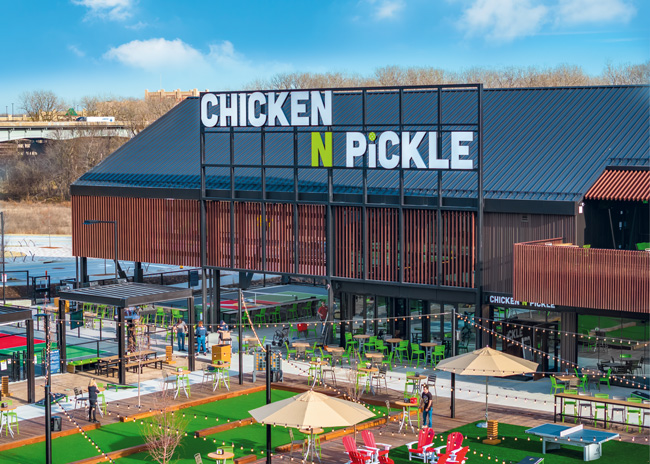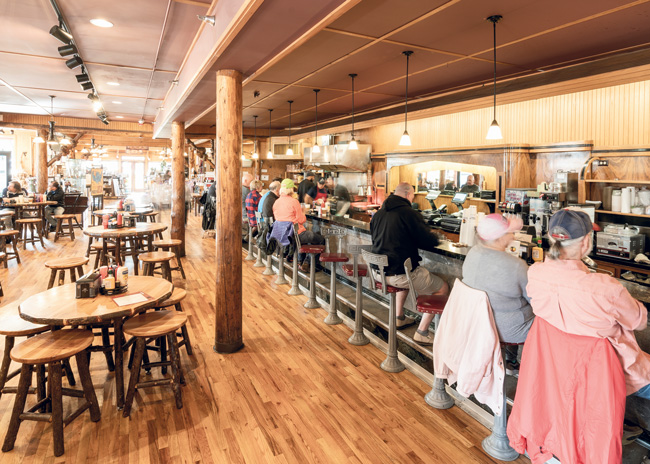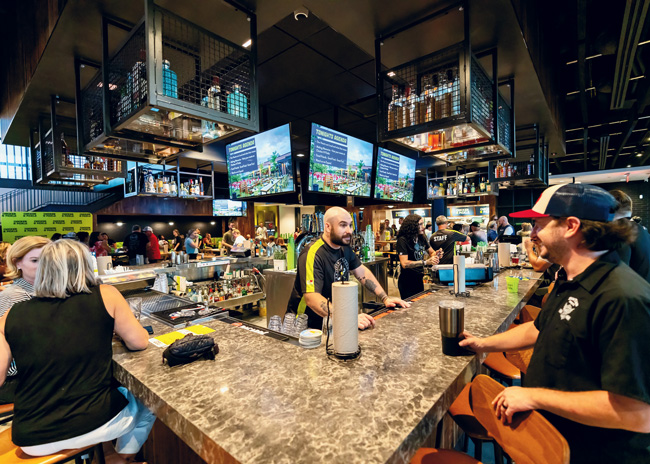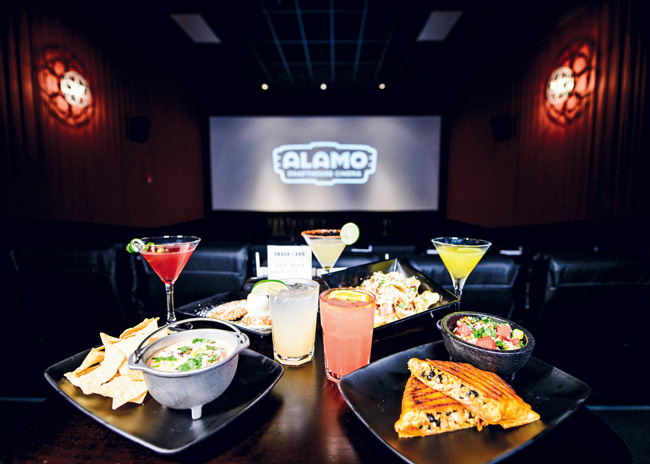Go ahead, play with your food.
 Photo courtesy of Chicken N PickleMini golf, pickleball, arcade games, virtual reality experiences, cinemas, national parks, cultural attractions, cornhole, curling (yes, curling!) — post-pandemic fun- and socialization-deprived consumers seem to be saying, “Bring it all on! And while you’re at it, feed us well and shake us up a craft cocktail or two.” Operators in the recreation (rec) and leisure space continue to heed the call, breathing fresh life into eatertainment and delivering food and beverage programs that fuel the experience and the fun, wherever and whatever it might be.
Photo courtesy of Chicken N PickleMini golf, pickleball, arcade games, virtual reality experiences, cinemas, national parks, cultural attractions, cornhole, curling (yes, curling!) — post-pandemic fun- and socialization-deprived consumers seem to be saying, “Bring it all on! And while you’re at it, feed us well and shake us up a craft cocktail or two.” Operators in the recreation (rec) and leisure space continue to heed the call, breathing fresh life into eatertainment and delivering food and beverage programs that fuel the experience and the fun, wherever and whatever it might be.
Jake Crabtree, vice president of culinary at Denver-based SSA Group, which provides foodservice and retail contract management services to zoo, aquarium and museum clients across the country, says that over the past couple of years the “floodgates have opened.” Not only is the public flocking once again to cultural attractions such as those SSA serves, but clients are intently focused on providing higher quality, chef-driven foodservice programs.
“Food at many of these attractions used to be largely an afterthought, but that is changing,” Crabtree says. “We help ensure that guests can enjoy not only the main attractions but also some great culinary experiences while they’re there. Nobody wants a tired, overpriced hamburger wrapped in paper sitting on a warming shelf. Today, it’s all about quality, on-trend food and beverage options that support and enhance the broader experience and that mirror what guests expect from the restaurant world outside.”
That means providing elevated, creative versions of familiar favorites and weaving in local influences and ingredients, Crabtree adds. Universally popular chicken tenders, for instance, feature fresh, hand-breaded chicken. Club sandwiches might feature candied bacon and grain bowls might replace traditional white rice with trendier farro or quinoa. “Those types of culinary touches make a big difference,” Crabtree notes. “We always try to do something a little different, to use fresh ingredients, colors, textures and flavors that entice guests to purchase food while they’re enjoying the attractions.”
Providing quality food and beverage programs also means offering more healthful, plant-based foods and beverage options that go beyond traditional sodas, Crabtree adds. It means serving Instagram-worthy presentations and maintaining a strong focus on sustainability in product sourcing and preparation as well as on waste reduction. In venues throughout the rec and leisure space it means building foodservice programs that help operators fully leverage revenue-generating opportunities.
“When we look at providing food and beverage for our partners, we’re looking at different operational needs. There’s standard visitor traffic, typically served by cafes and food carts throughout a given venue,” Crabtree says. “But there are also evening special events, park buyouts and large-volume catered functions. We need to be able to satisfy demands for both. Every facility’s infrastructure and property flow are different, though. So, generally, we do that by using a commissary approach, which includes batch cooking throughout the day, and establishing tight systems to ensure consistency at volume. We rely heavily on ventless and rapid-cooking technologies and are in the process of shifting to electrified kitchens in some locations as part of our, and many of our clients’ mission, to operate more sustainably.”
 At Yellowstone National Park’s General Stores, Delaware North focuses on creating unique destinations that enhance the guest experience. Photo courtesy of Delaware North
At Yellowstone National Park’s General Stores, Delaware North focuses on creating unique destinations that enhance the guest experience. Photo courtesy of Delaware North
Strategic Destination Dining
Indeed, one of the biggest challenges foodservice operators in traditional rec and leisure settings face can be infrastructure. Typically not built with sophisticated foodservice programs in mind, and often sited in historic buildings on protected landscapes, venues at some attractions demand extra creativity and flexibility on the part of operators in order to stay up to date while also meeting high volume and speed-of-service needs.
Brian Sterner, vice president of food and beverage for Delaware North’s Parks & Resorts division, says it’s a familiar challenge. His division services iconic attractions, including Niagara Falls State Park, Yellowstone and Yosemite National Parks, Yavapai Lodge at the Grand Canyon and the Kennedy Space Center, and in recent years has grown through acquisition and development of lodging properties near the gateways to such attractions.
“A lot of the operations within the parks and attractions themselves are outdated and, in some cases, are grandfathered in under historic preservation laws,” Sterner notes. “As we can, we take the opportunity to update and adjust infrastructure, but knocking down walls or adding ventilation is difficult to do. We don’t want to change the nature or footprint of the historic buildings. That means we’re increasingly looking at multifunction, ventless equipment. We also don’t have gas in many of our locations, so we’re forced to embrace electric. That’s not a bad thing. It opens the door to bring some unique pieces of equipment into concessions settings that may have not demanded them in the past. Do we still have hot dog rollers? Sure. But we also now rely on categories such as combi ovens and air fryers to expand and enhance what we can offer.”
What Delaware North can now offer is a diverse array of foodservice and retail programs strategically designed to ensure food and drink play strong, integrated roles in creating unique guest experiences. Sterner references the company’s work at Yellowstone National Park. “We recently retained our contract to operate the general stores within the park, signing on for an additional 15 years. Part of the RFP included a commitment to give each of the venues served, which historically had very similar food and beverage offerings, its own distinct character.”
Moving away from old-school, cookie-cutter concessions, Sterner says the focus has shifted to creating wow moments and signature, destination-dining attractions. As part of that strategy, the company showcases local and regional ingredients and culinary traditions. “At Yellowstone, for instance, we’re partnering with Native American producers and growers in Montana and Wyoming to feature products such as bison and elk burgers and tacos, and locally grown rice and beans,” he notes. “We do the same for beverages. At Yavapai Tavern at the Grand Canyon, for instance, we showcase products from local distilleries and craft brewers via LTO offerings we call Tap Takeovers. It’s a lot of fun, and it helps give visitors more authentic, immersive experiences.”
Next-Gen Eatertainment
Consumers aren’t just headed to traditional cultural and natural attractions in search of fun, immersive experiences. They happily embrace a fast-growing array of eatertainment concepts that bring food, drinks, fun and games together under one roof. According to industry traffic tracker Placer.ai, foot traffic in the eatertainment segment was up 3.8% in 2022 relative to 2019 and 17.3% relative to 2021. And in January 2023 alone, Placer.ai reported visits to such concepts increased more than 20% while other segments struggled to see traffic growth above 5% that month.
Global commercial real estate and investment management firm JLL, in its 2023 Entertainment Report, cited data from the IBISWorld forecast noting that Americans’ total recreation spending was on track to grow by 10.2% in 2023. The report predicted among top entertainment categories expected to have new openings in the future, eatertainment concepts, those offering multiple types of games plus foodservice, ranked highest at 33.9%. Close on its heels, at 32.4%, was “competitive socializing,” concepts offering a single game activity, such as darts or pickleball, along with foodservice.
“The social entertainment category has been exploding and evolving,” notes Mathew Focht, founder and CEO of Emerging, a venture capital and strategic advisory firm that helps restaurant and entertainment brands leverage technology, optimize operations and scale for growth. “There are a few legacy eatertainment brands, but many weren’t especially known for their food and beverage programs,” Focht says.
Emerging is especially excited about next-gen eatertainment and competitive socializing brands doing innovative work to marry familiar game play with high-tech upgrades and elevated food and drink options. Its portfolio includes U.K.-based Puttshack (11 U.S. units open, 11 in development), a high-energy mini-golf concept starring tech-infused golf balls that automatically track gameplay; F1 Arcade (2 U.S. locations open, 20 planned), a social gaming experience built on full-motion, immersive Formula 1-style racing simulators; and Flight Club (5 U.S. locations open, 2 in development), which does for darts what Puttshack and F1 Arcade do for social-gaming, mini-golf and racing.
While their game foundations are different, their foodservice strategies are similar, showcasing elevated, globally inspired, sustainably driven menus and full bar programs touting signature cocktails, mocktails and beer, including local craft brews.
Who’s welcome? Everyone, and that’s the key to success in the segment, Focht says. Such next-gen eatertainment venues tout accessible, experiential and culinary appeal to Baby Boomers, families with kids, couples on dates, clusters of friends and large corporate groups, with many operating from early morning to late night.
“A lot of these concepts do very large volumes and are very profitable,” Focht says. “Technology has transformed and opened up gaming experiences to broader demographics. Anyone can play. It’s fun and addictive, and when you combine great, interactive entertainment with top-notch culinary and bar programs, it’s a winning formula.”
 Photo courtesy of Chicken N Pickle
Photo courtesy of Chicken N Pickle
Fun + Food: Chicken N Pickle
Headquarters: Kansas City, Mo.
Founded: 2016
Units: 9 open, 7 in development
Concept: Indoor/outdoor dining and entertainment featuring pickleball courts, yard games, casual chef-driven restaurants, sports bars, rooftop patios
Menu highlights: Signature wood-fired chicken, smoked wings and ribs, salads, elevated burgers and fried chicken sandwiches, shareable snacks, cocktails and mocktails, extensive beer selection
Key equipment: Wood-burning rotisserie ovens, smokers, grills, fryers, combi ovens
“We serve an average of 500,000 to 700,000 people annually per unit, depending on size and market. Compared to traditional restaurants, that’s a lot of volume to handle, but our kitchens are large — typically 2,000 to 3,000 square feet — which helps,” notes Joe Palermo, vice president of operations at Chicken N Pickle. “We smoke all of our own meats, and we’re known for our rotisserie chicken, which is cooked over oak throughout the day. All of our proteins are sustainably raised: no hormones, no antibiotics, always fresh, never frozen. We make our own fries fresh every day. We also apply the same philosophy that drives our food program to our beverage program. For example, we use cold-pressed, non pasteurized, low-sugar juices for all of our mixers. And every unit showcases a variety of local craft beers.”
Palermo adds that while pickleball is the “lightening in a bottle” foundation for the concept given the sport’s meteoric rise in popularity, it directly accounts for 10% to 12% of a typical unit’s revenues. Food, drinks and a robust private-events business kick in the balance.
Fun + Food: Your 3rd Spot
 Photo by Brandon AmatoHeadquarters: Boston (Part of AMP Up1 Hospitality Management)
Photo by Brandon AmatoHeadquarters: Boston (Part of AMP Up1 Hospitality Management)
Founded: 2022
Units: 1, development planned for 9 states
Fun: 80-plus old-school and high-tech games, from giant Jenga, cornhole and curling to state-of-the-art arcade and video games, plus casually upscale food and beverage in a 30,000-square-foot facility
Menu highlights: Globally inspired, sharable small plates (i.e., spicy tuna crispy rice, Taiwanese popcorn chicken, wagyu beef tartare toast, smoked brisket tacos); creative cocktails/mocktails, craft beers
Key equipment: Combi and impingement ovens, fresh pizza dough stretchers, fryers, grills/griddles, commercial vacuum sealers
“Most of our team has a lot of experience in the eatertainment space, and we saw big benefits for creating a new brand coming out of the pandemic,” notes Doug Warner, chief innovation officer at AMP Up1 Hospitality Management. “There are a lot of big-box real estate opportunities opening up for something of this size and scale. The pandemic also underscored that we all have a need to connect, to socialize again, and we know there’s a desire, especially among Millennials and Gen Z, for experiences. It’s a perfect storm for this concept, and the reception for our first Atlanta unit has been terrific.”
Your 3rd Spot guests pay a set entry fee, giving them access to any and all games and activities and the freedom to choose their own adventure. The Atlanta Your 3rd Spot includes a large bar, semi-private cabanas and a dining area called The Garden. “Connecting people and building community are big goals, so we knew we wanted to do small-plates menus.” Warner says. “Guests order three or four dishes per person to share, and it creates a nice element of socialization.
We fire when ready: As dishes are prepared, they’re delivered right to the table wherever in the venue the guest is, which helps to keep things moving quickly.”
Fun + Food: Alamo Drafthouse Cinema
 Photo courtesy of Zane RoessellHeadquarters: Austin, Texas
Photo courtesy of Zane RoessellHeadquarters: Austin, Texas
Founded: 1997
Units: 40 open nationwide, 4 in development
Concept: A movie lover’s oasis offering full-menu and movie-inspired limited-time offers prepared fresh to order, craft cocktails and local brews served in-seat and in themed on-site bar/restaurant spaces
Menu highlights: Burgers and sandwiches; specialty hot dogs; snacks (i.e., chips and queso, fried pickles, crispy buffalo cauliflower); salads; entrees (i.e., Ropa vieja tacos, Hatch green chili mac and cheese, roasted vegetable quinoa bowl); fresh-baked cookies; pizzas; boozy shakes; vegan items (i.e., avocado toast, curry chickpea salad, seared tofu sandwich)
Key equipment: Popcorn makers, fryers, flattop grills, pizza ovens, shake machines
“We seat about 100 viewers in an average theater, and then about 15 minutes later we seat another hundred in the theater next to it, and so on. It’s like filling up a restaurant in 15-minute intervals, so our food and beverage strategy is pretty quick service and our schedulers are akin to maître d’s, helping manage flow and volume,” says Brad Sorenson, corporate R&D chef at Alamo. “It’s more challenging to get the timing right than in a traditional restaurant, but we don’t cut corners.
Everything is freshly prepped in house. Our burgers and pizzas are made to order, and we make our pizza dough fresh in-house. We’re also known for developing
special menu items inspired by particular movies.”
Such LTO examples have included Star Wars milkshakes, Lord of the Rings marathon feasts, pink cocktails with a special Barbie brunch menu, and tea and treats served with period films. “It’s a lot of fun, and we’re proud of the quality we’re able to offer,” Sorenson adds. “Most orders are served to guests right in their seats. They usually come in a little early and place their orders, but they can order any time during a movie as well.”



